Différents signes occultes répertoriés par l'auteur J.S.M. Ward
 le signe de "ciel et de terre" ou "heaven and earth" est souvent associé au thème de la résurrection ou à des divinités qui vont sur terre pour accomplir une mission. C'est un signe très ancien et qui est répandu sur tous les continents. Ici: Bouddah, Jésus, Diane et Calypso et Quezalcoatl
le signe de "ciel et de terre" ou "heaven and earth" est souvent associé au thème de la résurrection ou à des divinités qui vont sur terre pour accomplir une mission. C'est un signe très ancien et qui est répandu sur tous les continents. Ici: Bouddah, Jésus, Diane et Calypso et QuezalcoatlNous pouvons enfin donner des noms préçis aux différents signes maçonniques répertoriés par Johannes Rotkranz. Voir:http://complotquebec.blogspot.com/2007/07/les-12-signes-de-reconnaissance.html
En gros, les francs-maçons d'aujourd'hui ne font que répéter les même signes de la main qui puisent leurs origines dans les "écoles de mystère" de l'antiquité et qui ont par la suite servi de base commune à toutes les religions et à tous les mouvements occultes et ésotériques qui ont par la suite existé. Ces même gestes se retrouvent dans à peu près toutes les civilizations antiques sous forme de tableaux ou de scuptures etc. Ces gestes sont aussi présents dans les tableaux religieux chrétiens.
Le chef maçonnique Hubert-Jean Valcke avait donc raison quand il affirmait ici que ces gestes étaient plus ancients que toutes les religions.
http://complotquebec.blogspot.com/2007/02/entretient-avec-hubert-jean-valcke-de.html
Si vous voulez en savoir plus sur le système de J.S.M. Ward:
http://www.indotalisman.com/handsymb.html
Je vais recopier les infos en Anglais au cas où le lien ne fonctionnerait plus un jour.
- Sign of Preservation
- Sign of Faith
- Sign of Distress/Surrender
- Sign of Death
- Sign of Praise
- Sign of the Heart
- Sign of Prayer
- Sign of Benediction or Blessing
- Sign of Secrecy
- Sign of Destruction
- Sign of Exultation
- Sign of Reverence
- Sign of Horror
- Sign or Resignation
Sign of the horn: the well known "devil sign"
The vesica pisces sign: The well known "ok" sign
Sign of completion: similar to the sign of praise described above except that the arms are inclined downwards
- Sign of Heaven and Earth
- Sign of Despair/Regret
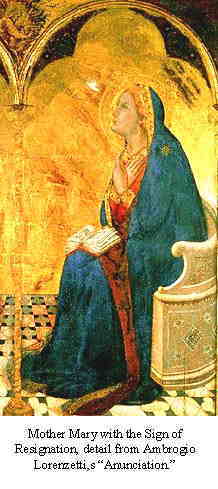 | 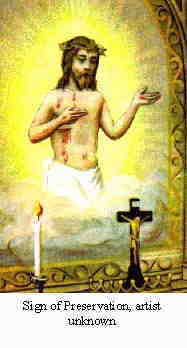 |
Sign of Preservation
There are many variations of this sign. Basically, it is posed by placing one hand over the heart and raising the other at an angle at the elbow with the hand pointing upwards. In some forms, it is the index finger that points skyward. In most depictions of this sign it is the left hand rather than the right that is raised. There are numerous instances of this pose in Egyptian art. The Egyptologist, E.A. Wallis Budge, interprets the hieroglyph with this sign as Hen, or "praise." The god Anubis is often represented with this hand posture, and murals in the palaces and tombs of the pharaohs often illustrate votaries of Ra with this significant gesture. This sign is also found in the Minoan and Mycenaen civilizations. In Christian art, Jesus is often portrayed assuming many occult hand signs, among these is the Sign of Preservation. The sun god Damuzi of the Babylonians while descending into the underworld likewise bears this sign, as depicted on certain objects. In his book mentioned previously, J.S.M. Ward tells of a Roman sarcophagus in the Bardo Museum, Tunis, showing the emergence of Jonah from the whale that swallowed him for three days, and making the Sign of Preservation--in effect, indicating that his life was saved. Among the mystical Islamic sects, the Whirling Dervishes appropriate the use of this important hand pose in their ceremonial rites and practices. In archaic times, the Sign of Preservation was adopted by those petitioning the deity for the preservation of oneself or someone else, and 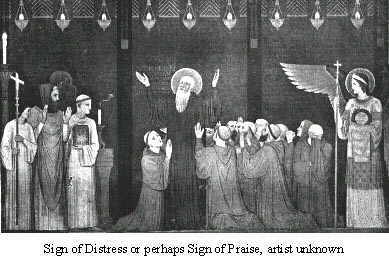 with the strong conviction that the request was granted. In contradistinction to this, it was also employed by those of high spiritual attainment assuring others of their salvation. In Christianity it is often associated with the Second Person of the Holy Trinity.
with the strong conviction that the request was granted. In contradistinction to this, it was also employed by those of high spiritual attainment assuring others of their salvation. In Christianity it is often associated with the Second Person of the Holy Trinity.
Sign of Faith
This sign resembles the Sign of Preservation with the exception that the hand pointing upwards is not squared at an angle and not pointing to the sky. It points outwards away from the body. Like the above sign, many examples of these are to be found distributed all over the world.
Sign of Distress/Surrender
When the two hands are lifted upwards above the head with the elbows bent--this is known as the Sign of Distress. This is one of those universal hand signs, and it seems almost human nature to fling the hands into the air when in despair or when faced with overwhelming pressure as a sign of psychological turmoil and the "giving-in" to a certain situation, or when feeling helpless. Therefore, it is not surprising when we find the use of this sign all around the globe as depicted in artistic works, and experientially in everyday life. This sign is an appeal for aid and is universal like many of the other signs mentioned in this section. Its use can be traced as early as 3,000 B.C. Quetzalcoatl, one of the gods of the Mayans, is sometimes depicted 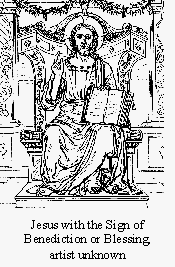 with this hand pose.
with this hand pose.
Sign of Death
This hand sign is related to the throat chakra, or psychic center. It consists of placing the hand's edge-whether left or right hand-at the throat. The thumb points directly at the throat itself. It is actually a moving gesture and is effected by moving the hand's edge across the throat as if to cut it. This sign suggests that something is to be terminated or killed, or that it is already dead. The ancient Romans and Egyptians were well familiar with this sign and in some Christian paintings of the crucifixion, the disciple John the Beloved is portrayed with this sign of cutting the throat while standing before the crucified Jesus. Arabs and Sudanese make use of this sign to swear their innocence uttering that God should cut their throats should they be telling a falsehood. Several American Indian tribes employ this sign as a salutation meaning that they are "faithful or true unto death."
Sign of Praise
This sign is similar to the Sign of Distress except that the hands are not lifted above the head but extended forward in front of the body, inclining upwards with the hands facing outwards and the elbows bent. This is also a greeting sign and the initial start of the salaam gesture of the Arabs. 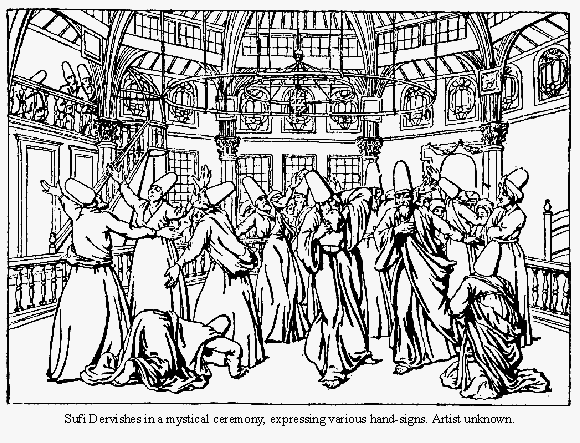
Sign of the Heart
This sign is accomplished by placing the hand over the heart. A survival of this gesture in modern times is the bowing of a gentlemen to a lady with his hand to his heart as a salutation of respect, or as it was customary in the 17th and 18th century in Europe, for a man to remove his hat and to place it at the heart region when greeting the opposite sex. This is a hoary sign. It is to be found in ancient Egypt, Rome, and even in Crete in the Minoan period. It is also to be seen in the mosaic art of the many old churches and cathedrals. The meaning of this sign is a little obscure. It has been suggested that it signify faith or fidelity. However, with the placement of the hand at the heart we may make a conjecture and say that it concerns the finer sentiments of a person conveyed to the object of his attention or affection.
Sign of Prayer
This is probably the best known of ecclesiastical signs which is also used by the lay person. It consists of placing the palms of the hands together with the fingertips pointing in an upward direction. Another Sign of Prayer is the folding of the hands together intertwining the fingers. 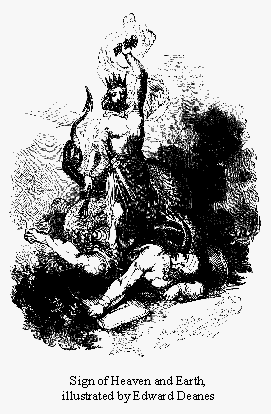
Sign of Benediction or Blessing
In Christianity, this sign is utilized mainly by the priesthood. It is used by priests to bless people and consecrate objects. To assume this sign, the third and fourth fingers are folded onto the palms with the index and middle fingers held upright. The thumb may also be erect or it may be folded upon the ring finger. The significance of the erect thumb and first two fingers in the act of blessing is that the grace, virtue, and power of the Holy Trinity are being conveyed. Occultly, the subtle energies flowing from the hands are stronger at the terminal points of these digits than they are at the ring and little fingers.
Sign of Secrecy
This is a sign that has survived to contemporary times and can continually be seen in everyday life. It probably originated in Egypt during the heydays of the Mystery Schools. This sign was associated with Horus, or Harpocrates--one of the forms of Horus. This sign is executed by putting a finger to the lips as though to seal it. Its significance is that of secrecy and silence. In the Mystery Schools the Initiates were pledged to a vow of secrecy, never revealing the secrets of the Temple unless authorized to do so. Even nowadays, the following injunction may be found in occult schools: "know, dare, do, and be silent."
Sign of Destruction
When one or both of the hands are seen on the solar plexus in religious art, it signifies destruction. We can understand the significance of this sign when viewed from a metaphysical point of view. The solar plexus chakra is a storehouse of potent energies that may be used for good or ill. When this center is awakened prematurely in a disciple's life, it may cause 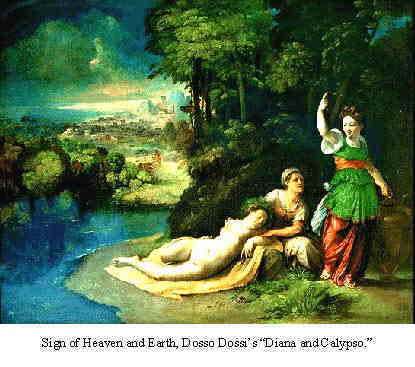 problems that the disciple is not equipped as yet to handle. Physical, physiological, and psychological--not to mention karmic difficulties--might arise when a disciple foolishly stimulates this center. The solar plexus chakra is an emotional focus and by being polarized at this level one may have trouble extricating oneself from the lower instinctive and egoistic nature. The disciple may be destroyed by this center and evolutionary progress postponed, thus the hand gesture on the solar plexus came to be associated with destruction. There are numerous examples of the Sign of Destruction in Art. In India, Shiva, the Destroyer is often depicted with this gesture. Many Greek and Christian art-forms also bear personages with this sign.
problems that the disciple is not equipped as yet to handle. Physical, physiological, and psychological--not to mention karmic difficulties--might arise when a disciple foolishly stimulates this center. The solar plexus chakra is an emotional focus and by being polarized at this level one may have trouble extricating oneself from the lower instinctive and egoistic nature. The disciple may be destroyed by this center and evolutionary progress postponed, thus the hand gesture on the solar plexus came to be associated with destruction. There are numerous examples of the Sign of Destruction in Art. In India, Shiva, the Destroyer is often depicted with this gesture. Many Greek and Christian art-forms also bear personages with this sign.
Sign of Exultation
This hand pose is a sign of joy and satisfaction; it is done by extending the hands above the head with the fingertips of the hands touching. Though not as numerous as some of the other signs, there are several examples of these in Christian art. In China, the Hung Society uses this sign to represent the metal element. 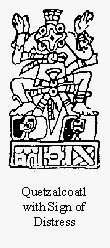
Sign of Reverence
Reverence in the sign language of the Mysteries, is indicated by the shading of one's eyes with the hand, whether left or right. In some variations of this sign the eyes are fully covered. This sign originated in cultures where it was impolite to look directly at one's superior; for instance, a soldier would make this sign when saluting a superior officer. Another possible origin of this sign is the experiences had by blessed individuals during angelic visitations. The presence of these spiritual beings compels the beholder to shield their eyes from the angelic radiance. This hand gesture is not unique to any race for it is to be found distributed all over the world--in Ceylon, Australia, Africa, Asia, and Europe.
Sign of Horror
One of the dramatic signs, the gesture of horror is made by extending the right hand, palm outwards, while the head is turned to the right as though refusing to see something objectionable or frightening. The left hand is this gesture point outwards and in a downward direction as if trying to expel something. Examples of this sign in art may be seen in the Vatican and in the British Museum. 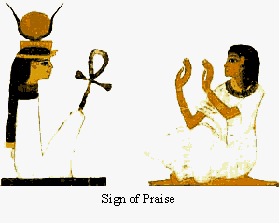
Sign or Resignation
This sign consists in crossing the arms upon the chest with the fingertips of the right hand on the left shoulder and the fingertips of the left hand on the right shoulders. This gesture is sometimes portrayed with the right hand over the left, but the reverse is regarded as a more proper representation according to tradition. This is another one of those signs that may have originated in the Mystery Schools of Egypt. The god Osiris and the statues representing Egyptian pharaohs are often depicted in this pose by artisans. For some specific reason the Egyptians also buried their dead in this manner, with the hands of the mummy crossed upon their breast. Even the sarcophagi or mummy cases of the deceased bear a pictorial resemblance of them with the same sign. In the Renaissance, artists often depicted Mother Mary with such a hand pose. Like the many hand gestures described herein, the Sign of Resignation generates a certain occult power of which we shall discuss later in an upcoming article when we apply and incorporate the sign in our mudra practices. The occult function of a sign is just as important as its esoteric meaning, perhaps even more so. 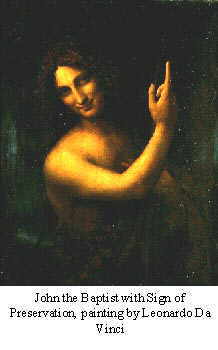
Sign of Heaven and Earth
This sign is executed by extending one hand above the head pointing skywards, and the other extended downwards pointing to the earth. According to Ward, the significance of this sign in Christianity is that someone had descended to Earth and later re-ascended to Heaven. Or alternatively, ascended to Heaven and later descended to Earth. There are numerous examples of this sign in Christian art related to the raising of Lazarus, the descent of Jesus into Hell to save the inhabitants, and Jesus' resurrection. There are many variations of this sign. Sometimes the hand with its open palm pointing upwards has its fingers together; occasionally we find examples where the index finger points upwards while the rest of the fingers folded onto the palm. The British Museum has a collection of Babylonian objects where the Sign of Heaven and Earth may be seen. In Greece, examples of this sign are associated with the Eleusinan Mysteries.
Sign of Despair/Regret
Regret, despair, and sorrow is indicated by resting the head upon the right hand and the left arm, which is horizontally across the solar plexus, supports the right elbow with its hand. Occasionally, this position is reversed. There does not seem to be any strict rule to this. In paintings with crucifixion themes, the Virgin Mary is often depicted with this hand position. There are examples of this sign of Persian and Greek origins preserved in museums all over the world.
8 Comments:
Un lecteur de pointer ce renseignement concernant un commentaire fait à commission TB:
et un Métis casqué a même lancé aux francs-maçons un avertissement concernant le retour de la spiritualité amérindienne.
http://www.ledevoir.com/2007/11/28/166391.html
http://www.michaeljournal.org/Ouellet%20Cardinal-circ-final.pdf
remarquez l'étrange poignée de main entre le cardinal Ouellette et le pape. Remarquez aussi que le pape Jean-paul II fait le signe de bénédiction (ce qui est normal) ce qui l'est moins c'est le signe du coeur qu'il fait avec la main gauche
La vrai inspiration de nos laïciste et de la DPJ:
LES RELATIONS ENTRE PARENTS
ET ENFANTS CHEZ LES SOVIETS
28 août 1939, l'action catholique, page 4
http://bibnum2.banq.qc.ca/bna/actioncatholique/
Radio-Vatican a annoncé récemment que le chef des Sans-Dieu sovietiques, Yaroslavaky, s'était adressé au Procureur général de I'union soviétique pour lui demander de poursuivre en justice les parents qui refusent d'envoyer leurs enfants dans les écoles athées; il parait en effet que les parents religieux de villages entiers boycottent les écoles soviétiques.
Le Procureur central a repondu en donnant l'assurance que dorénavant des tels refus seront punissables par la loi. Lorsqu'on se trouvera devant des cas d'obstination absolue de la part des parent, les tribunaux auront ordre de priver ceux-ci de leur droit d'éduquer leurs enfants et ils pourront décréter le transfert de ces derniers dans des institutions de l'État. En outre, les parents ne pourront désormais ni interdire à leurs enfants de suivre les cours d'instruction athée, ni faire pression sur eux pour qu'ils accomplissent leurs devoirs religieux; s'ils ne tiennent pas compte de celte Interdiction, ils seront considérés comme ayant enfreint à loi soviétique. D'autre part, une nouvelle loi est à l'étude qui permettra aux enfants de poursuivre leurs parents devant la loi pour excès d'autorité ou pour actes de représailles envers eux.
"Ia religion est chose privée" avait dit Karl Marx.
Lenine se montre plus exigeant' il distingue entre l'Etat et le parti communiste. Et il organise ce parti de manière à ce qu'il ne puisse s'accommoder de Dieu.
(même journal 18 sept. 1934, page 4)
le sénateur franc-maçon Jacques Hébert est mort
http://www.cyberpresse.ca/article/20071207/CPACTUALITES/71207046/6488/CPACTUALITES
L'article ne dis pas (naturellement) qu'il a reçu en 1985 une médaille maçonnique à la loge Montcalm du grand orient de France (en même temps que René Lévesque)
http://complotquebec.blogspot.com/2007/07/la-mdaille-maonnique-de-ren-lvesque.html
Tiens, le couple esclavagiste de Laval vient d'être acquitté. C'est drôle mais le monsieur fait le signe de la foi... Aucun rapport bien sûr.
http://www.cyberpresse.ca/article/20071207/CPACTUALITES/712070809/1019/CPACTUALITES
Tiens nos soldats meurent en Afghanistan pas seulement pour les intérêts US mais aussi (ou sourtout?) pour ceux des Russes (soviétiques?)
http://www.cyberpresse.ca/article/20071207/CPACTUALITES/712070796/1025/CPACTUALITES
«Mon pays [Russie] est très vulnérable, dit-il, parce que nous vivons dans le voisinage et nous ne voulons pas que les talibans ou Al-Qaeda connaissent du succès. C'est dans notre intérêt que les talibans soient le plus faibles possible.»
email de big cat (Montcalm Lévis, Mesplet étaient FM et probablement l'historien De Lagrave aussi)
Essais québécois - "Les trois batailles de Québec. Essai sur une série de trahisons"
Les raisons de la défaite
Fascinante, lyrique et sainement polémique, voire contestable, cette histoire des trois batailles de Québec se dévore littéralement.
Louis Cornellier
Le Devoir
samedi 8 décembre 2007
Aujourd’hui encore, les raisons de la défaite de 1759-60 continuent de susciter une polémique chez les historiens. Tous s’entendent pour reconnaître que le torchon brûlait entre Montcalm et Vaudreuil et pour affirmer que cette animosité entre les deux dirigeants n’a pas servi le sort de la colonie, mais l’unanimité s’arrête là.
Guy Frégault critiquait durement le général français en affirmant que « le 13 septembre devrait être connu sous le nom de la Journée des Fautes. Le demi-succès de Wolfe tient à ce que Montcalm commet encore plus d’erreurs que lui ». Cette interprétation a été reprise par l’historien canadien-anglais W. J. Eccles dans une notice relative à Montcalm, publiée dans le Dictionnaire biographique du Canada en 1974. Le général y est dépeint comme un militaire raté.
En s’inspirant de cette notice, qui fait autorité dans plusieurs milieux, le journaliste Louis-Guy Lemieux, dans son ouvrage populaire intitulé Nouvelle-France. La grande aventure (Septentrion, 2001), mène une charge radicale contre Montcalm. Il qualifie son bilan canadien de « catastrophique » et ajoute : « Il est impossible de trouver à cet homme un seul côté attachant. L’intrigue lui sert de stratégie militaire. La médisance et la calomnie s’attachent à chacun de ses pas. » Pis encore, il aurait été un capitulard et aurait méprisé les Canadiens. Lemieux, fidèle à Eccles, affirme donc que le vrai héros de cette triste histoire est Vaudreuil, « un grand gouverneur, peut-être le plus grand de l’histoire de la Nouvelle-France ».
Une contre-interprétation
L’historien Jean-Paul De Lagrave prend le contre-pied de cette version des événements dans Les Trois Batailles de Québec. Essai sur une série de trahisons. Ouvrage d’histoire traditionnelle, rédigé sous la forme d’un récit d’aventures très énergique, cet essai aux accents épiques entend rétablir l’honneur entaché de Montcalm et redistribuer les blâmes. « Sous l’apparence d’une érudition de bon aloi, écrit De Lagrave, [Eccles] trace de Montcalm un portrait caricatural qu’aucun historien objectif n’oserait signer. [...] Aucun historien jusqu’à ce jour, même pas Guy Frégault, n’a été plus injuste qu’Eccles envers la mémoire de Montcalm. »
Pour De Lagrave, « sortir les traîtres de l’ombre, c’est grandir l’action de ceux qui ont combattu pour la liberté de leur patrie au prix de leur vie ». Aussi, ajoute-t-il, l’histoire qu’il raconte « évoque non pas des vaincus, mais d’intrépides résistants ». Parmi ces derniers figure, au premier chef, Montcalm.
Le portrait du général que trace l’historien est sans équivoque. « Doué d’une imagination ardente, écrit-il, il brillait par les avantages d’une mémoire très fidèle. Possédant des goûts studieux, il était versé dans les langues anciennes et les lettres. Il adorait les sciences. » Père de dix enfants, il se distinguait, sur le plan militaire, « par sa vaillance et son sens de la stratégie ». Les Indiens le respectaient parce qu’il les traitait en égaux. Ces derniers, d’ailleurs, sur les Plaines, « ont été braves à l’extrême ».
Ce ne fut pas le cas de tous. Selon De Lagrave, en effet, « une série de trahisons ou de gestes équivalents ont permis aux envahisseurs de s’emparer de Québec ». Les traîtres, ce furent, entre autres, des pilotes de vaisseaux français passés dans le camp ennemi. Ce fut, aussi, François-Joseph Cugnet, un avocat de Québec, qui « indiqua à Wolfe le sentier de l’anse au Foulon ». Ce fut un certain Vergor, déjà accusé de trahison pour son comportement en Acadie, qui, chargé par Vaudreuil de garder l’anse, a préféré dormir. Le colonel Bougainville, quant à lui, fut simplement incompétent et en retard sur les événements, alors que Ramezay, lieutenant du roi à Québec, se contenta d’être lâche.
Le principal responsable de la défaite, toutefois, selon l’historien, reste Vaudreuil. « Il était dénué du jugement nécessaire pour remplir adéquatement ses fonctions de gouverneur de la Nouvelle-France, juge-t-il. [...] Il fit tout en son pouvoir pour contrecarrer l’action de Montcalm, et cette jalousie féroce à l’égard d’un grand général pava la route des envahisseurs. » Ces derniers, quant à eux, en particulier Wolfe et Amherst, se sont distingués par leur cruauté.
L’échec de la revanche
Tout, pourtant, n’était pas perdu. Quand Lévis revient vers Québec avec ses troupes en avril 1760, les espoirs sont permis. L’hiver a durement affecté les troupes anglaises retranchées dans Québec. Le commandant Murray, cependant, encore une fois, peut compter sur des traîtres du camp adverse pour le prévenir des assauts en préparation. L’armée anglaise sera néanmoins mise en déroute, mais Lévis fera l’erreur d’opter pour un siège de la ville au lieu d’y entrer. Quand les renforts anglais arriveront par le fleuve, en mai, la capitulation française devient inévitable. Conclusion de l’historien au sujet de cette deuxième bataille : « Une volée de traîtres et de déserteurs renseignait Murray de toutes les dispositions de Lévis. Celui-ci, durant la bataille et au lendemain de la victoire, fut un général médiocre. » Murray, lui, à la façon de son prédécesseur, jouera de la torche contre les Canadiens récalcitrants.
Les jeux, malgré tout, n’étaient pas encore faits. En 1775, les Fils de la Liberté des colonies américaines offrent aux Québécois de se joindre à eux dans la révolte contre les Anglais. Commandés par Montgomery et Arnold, ils marchent vers Québec pour la lutte finale. Selon De Lagrave, « l’adhésion au mouvement révolutionnaire fut quasi générale » au sein de la population d’ici. En choisissant le camp anglais, les seigneurs et le clergé ont donc trahi le peuple et fait échouer l’entreprise de libération menée par ces grands hommes que furent Arnold, Montgomery, Franklin et Mesplet.
Fascinante, lyrique et sainement polémique, voire contestable, cette histoire des trois batailles de Québec se dévore littéralement. Elle propose une sorte de pédagogie de l’admiration qui veut inciter à l’action. « Beaucoup pourtant cherchent encore leur patrie, conclut De Lagrave. Elle est là où les ancêtres ont versé leur sang pour la sauvegarder, lui assurer sa liberté, combattre pour elle. Et Québec, la vraie capitale, est et demeure le miroir de cette fierté de tout un peuple. C’est avec un peu de terre et beaucoup d’idéal qu’on fonde la patrie. »
http://www.vigile.net/La-desorientation-politique-est
Regardez la photo de Lévesque juste avant sa mort en train de rire au larmes avec Trudeau. Je suis convaincu de plus en plus que les 2 étaient membres de la loge Montcalm.
http://www.cyberpresse.ca/article/20071213/CPACTUALITES/712130645/6782/CPACTUALITES
Le FM Turcotte qui échange une poignée de main maçonnique avec son frère Bouchard. Notez le pouce sur la jointure.
Par ailleur, voici la version anglaise de ce site
www.waitingtorot.blogspot.com
Si vous avez des photos intéressantes naturellement envoyez les moi par email.
Roger Le Clerc de la loge liberté va présenter aujourd'hui son mémoire devant la commission bidon
http://www.newswire.ca/fr/releases/archive/December2007/13/c2507.html
Publier un commentaire
<< Home